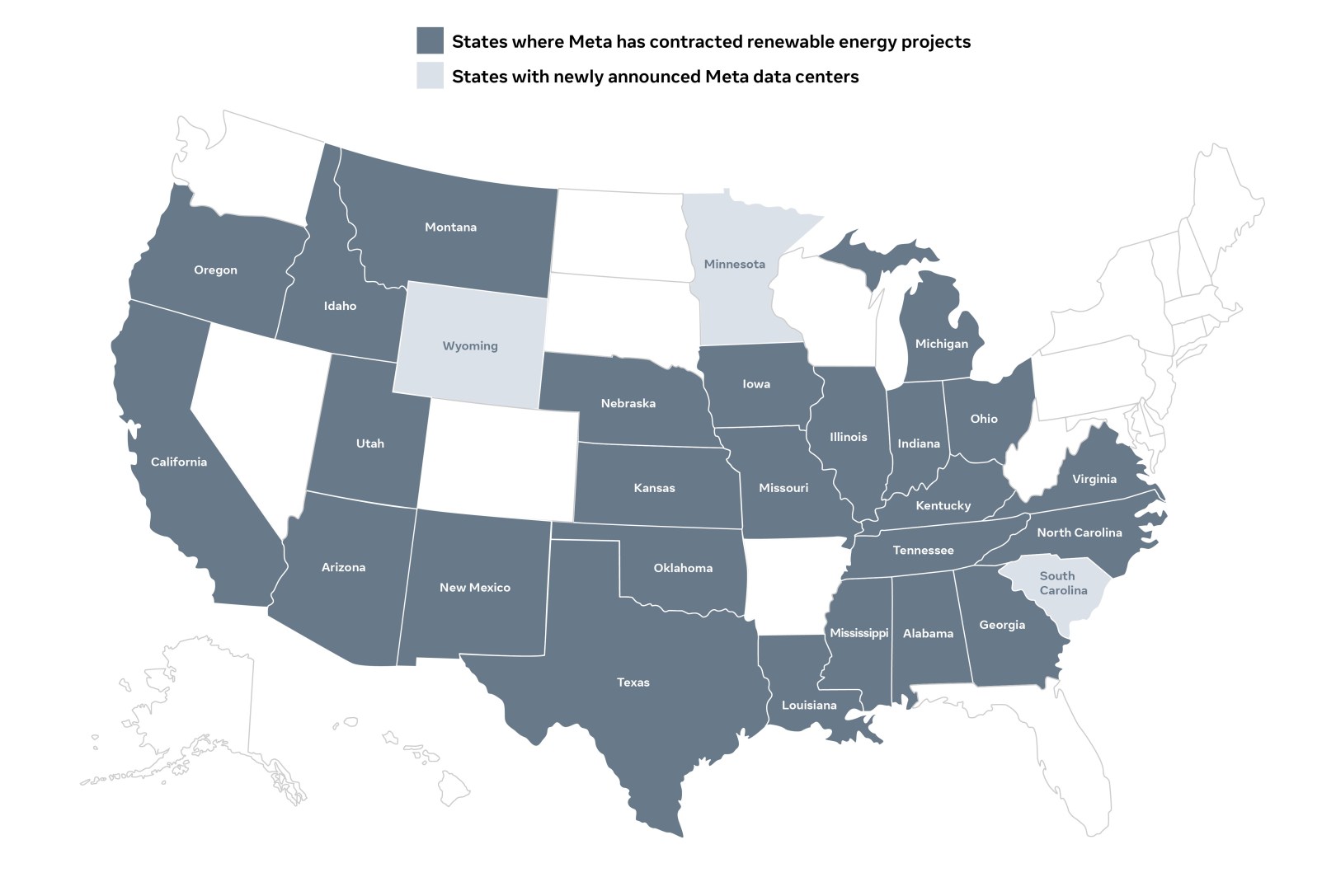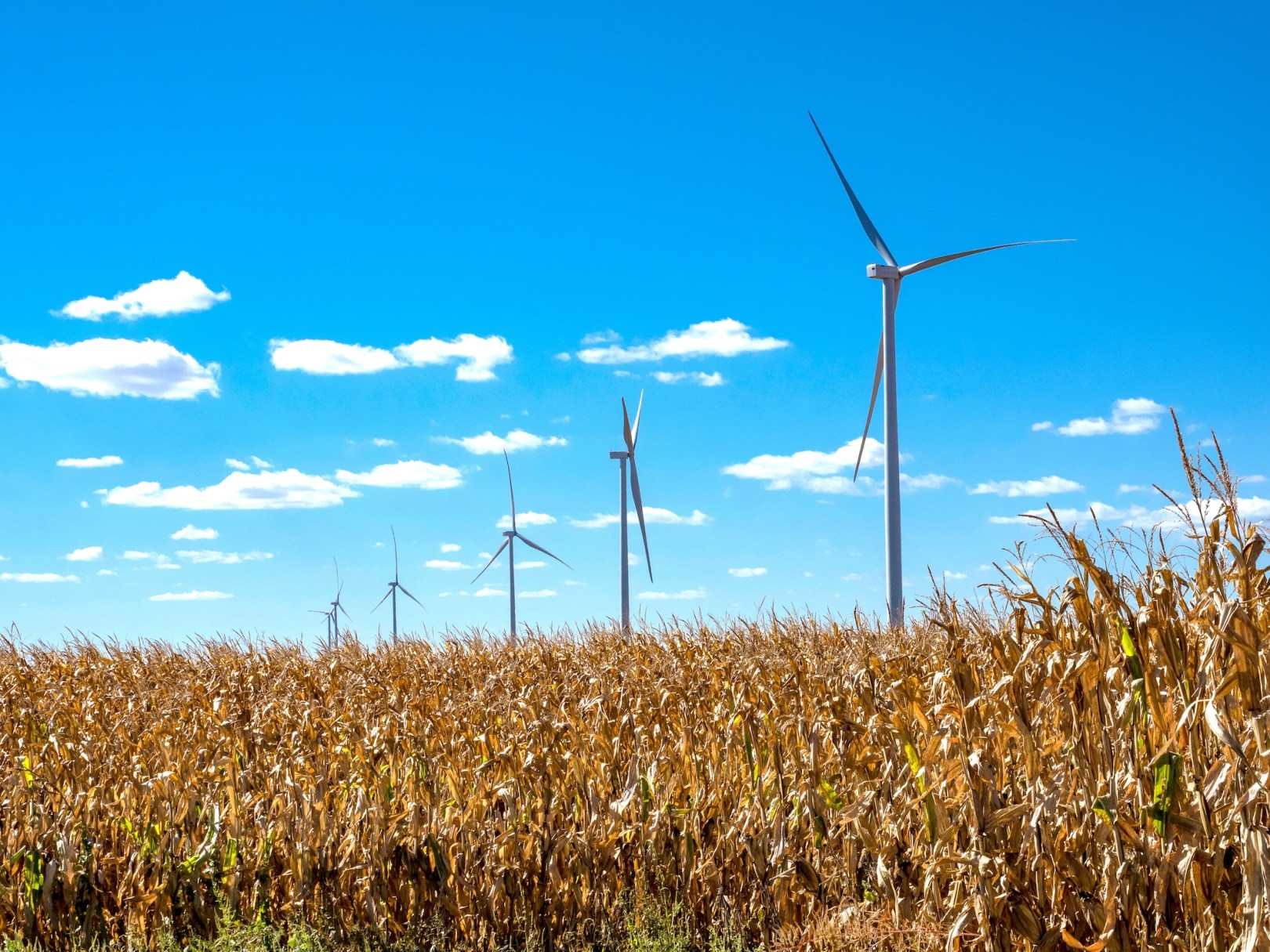At Meta, we work to design, build and operate some of the most innovative and sustainable data centers in the world. They provide the technology that billions of people use every day to connect and build community. Ensuring these world-class data centers are supported by clean and renewable energy is foundational to our approach. We recognize that adding new energy to the grid is important, not only because of our scale and scope as a company, but because we want to play a positive role in the communities in which we operate.
Since 2020, we have matched 100% of our annual electricity use with new renewable energy and have a long history of partnering with utilities and renewable developers to bring new wind and solar energy projects to grids where we operate. As a voluntary buyer of renewable energy, we prioritize supporting high quality, innovative clean and renewable energy projects around the globe, which is key to maintaining net zero emissions for our operations.
A fundamental tenet of our approach to renewable energy is the concept of additionality – partnering with utilities and renewable energy developers to add new projects to the grid. Over the last decade, we’ve contracted for over 12 GW of new renewable energy across the globe, making us one of the world’s largest corporate buyers of renewable energy.

Partnering with utilities to benefit everyone
Key to our utility partnerships is finding ways to grow the grid to benefit everyone, while ensuring we are able to power our operations and contract for enough renewable energy. This includes working closely with our utility partners to support new infrastructure like transmission lines and substations as they modernize their grids.
For more than a decade, we have partnered with local utilities to develop green tariffs to bring new renewable energy sources to the utilities’ systems to support our data center operations. Green tariffs enable approximately 50% of our renewable energy portfolio, and also provide a way for other energy customers to voluntarily add renewable energy to the grid. For example, we worked with the Public Service Company of New Mexico (PNM) to add 775 MW of new renewable energy and 100 MW of battery storage in the state. We collaborated with Rocky Mountain Power and Pacific Power to add over 1,700 MW of new renewable energy to the Utah grid.
Supporting quality projects and adding new renewable energy to the grid
Today, electricity load in the US is growing faster than in the past few decades. As this growth occurs, a diverse portfolio of resources is needed to ensure that the grid remains reliable. Meta is committed to doing our part to spur progress in bringing innovative energy technologies to the grid. We recently announced an agreement with Sage Geosystems to support the first deployment of next-generation geothermal power at scale east of the Rocky Mountains. This project—which will deliver up to 150 MW of new geothermal baseload power—will help significantly expand the use of geothermal power in the US and allows us to further diversify our portfolio with this clean, firm and resilient power source. Our commitment to long-term electricity purchases from burgeoning technologies like geothermal provides financial certainty to projects like this, helping them come to the grid faster.
We add renewable energy to the grids where we have data centers

We also routinely partner with renewable energy providers on power purchase agreements (PPAs) to match our operations with renewable energy. We have long-standing experience bringing new renewable energy to the grid and supporting projects that would otherwise not have been built. Our role in the enablement of these projects is offtaker – when developers construct and operate new projects, we purchase the renewable energy that is produced. By 2025 these wind and solar projects will have supported more than $14.2 billion in capital investment throughout the US, in addition to bringing new tax revenue and supporting more than 74,000 jobs over 10 years through project construction.
Economic Impact
$14.2B total capital investment throughout the US by 2025
Jobs Created
74K jobs created over 10 years through renewable energy projects

Currently, 88 of the 117 projects in our portfolio are online and producing power. Long-term financial commitments like these, from companies like Meta, play a critical role in helping these projects get built. We often work to ensure new projects are connected to the same grid as our data centers and prioritize those that contribute the most to grid reliability (e.g., by giving energy to the grid when the grid most needs it), while optimizing for emission reductions. A few key projects include:
- Partnership with Singapore government agencies to support a 100 MW floating solar project, which will be the largest in the country once completed.
- Partnership with Highfield Energy Services on one of the largest solar agreements in Ireland, supporting 190 MW of solar from two projects in Wexford and Meath, close to our Clonee Data Center.
- Partnership with PNM and NextEra Energy Resources on Sky Ranch Solar Energy Center, a 190 MW solar facility paired with a 50 MW 4-hour battery energy storage system, in New Mexico.
Global data centers and operational renewable energy megawatts by year

The role of renewable energy certificates
Like many companies with renewable energy goals, we receive renewable energy certificates (RECs) from the projects we enable. RECs are essential tracking mechanisms that allow us to maintain a ledger of what clean energy was actually produced each year from our renewable energy projects across different states and countries. In many of the states in which we buy renewable energy, we are not the only buyers – utilities, other corporations, public entities like cities, universities and school districts also utilize RECs to track the delivery of clean electricity. We use the ledger at the end of year to compare these RECs to how much electricity was consumed at all of our offices, data centers and other buildings, and align to the best practices for voluntary corporate renewable energy buyers. And, importantly, we also consult with third party auditors who review and confirm that our energy accounting is accurate.
While the majority of our renewable energy portfolio is contracted through long-term agreements like PPAs and green tariffs, in some markets (particularly outside the US) clean energy procurement options are more limited. In these instances we look for opportunities to structure long-term agreements in a way that supports deployment of new renewable energy projects, in accordance with guidance from industry organizations and standard-setting bodies like RE100 and Greenhouse Gas Protocol. For example, our tax equity transaction with Prospero Solar was a direct investment in a long-term project where we also purchased the RECs via long-term contract to help meet our renewable energy goals. We strive to support quality, long-term projects, and only a small percentage (less than 5% of our reported 2023 renewable energy purchases) of our renewable energy is from short-term unbundled RECs purchases.
Evolving our approach
The quest for reliable, affordable and carbon-free energy solutions is a global challenge that requires multi-faceted exploration and innovation. Since 2020, we have maintained net zero emissions in our global operations. To achieve this, we reduced our emissions by 94% from a 2017 baseline, primarily by matching 100% of the electricity use of our data centers and offices with renewable energy and addressing the remaining emissions with projects that remove carbon from the atmosphere. Our work to bring on new renewable energy projects to the electricity system also means we need new tools and improved greenhouse gas accounting frameworks to drive more targeted investments through an improved understanding of the emissions impacts of our facilities and the projects we support. We work to advance these efforts through partnerships like the Emissions First Partnership, which works to implement better data accounting to promote renewable energy projects in areas where they will have significant emissions impact.
We are continually looking at innovative ways to bring new energy to the grid to maximize the positive impact of the energy projects we support – and we’re committed to working with the industry to transform the grid.
News
Get the latest news about our sustainability work, download reports and resources and explore our energy dashboards.

Meta launches 2024 Sustainability Report
Meta is proud to share its 2024 Sustainability Report highlighting the progress we’ve made towards our net zero, climate, water, energy and supply chain goals and commitments.
August 28, 2024
Growing Our Commitment to Carbon Removal with the U.S. Department of Energy
Meta is pledging to contract at least $35 million for carbon removal projects.
October 11, 2024
Estimating embodied carbon in data center hardware, down to the individual screws
A new approach to identify opportunities to reduce emissions.
September 10, 20242025 Sustainability Report
Learn more about our progress as we work to achieve net zero emissions across our value chain and become water positive in 2030.

